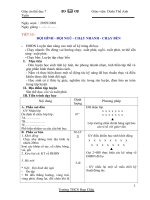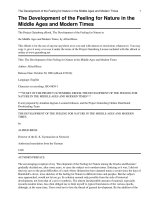Workbook for organic synthesis the disconnection approach i
Bạn đang xem bản rút gọn của tài liệu. Xem và tải ngay bản đầy đủ của tài liệu tại đây (39.68 MB, 546 trang )
worl
•
organlc
synthesis
Warren
Preface
This workbook accompanies the text Organic Synthesis: The Disconnection
Appmach. Tt contains fllrther examples, problems , and solutions undee the
same chaplee headings as those of the maio texto 1 assume lha! you have read
the corresponding chaplee in the tex! before tackling the chaplee in the workbook . You should then find examples and problems 10 help you understand
each parl oC the chapler in the maio text.
Within each chapler, the problems and examples are arranged either 10
follow lhe same organisatioll as Ihal oC lhe main lexl Uf lu presen! a series
graded in difficulty. Particularly easy or difficult problems are so labelled tha!
you can avoid Ihem ir you wanl too My prograrnmed text Designing Organic
Syntheses, Wiley , C hichester, 1978, provides another graded series of
problems and solutions within a similar framework .
My chief thanks go to Oenis Marrian who gave me vigorous encouragement
as well as checking all the text, diagrams and references and providing index
and formula indexo His hard work and that of Marilyn Buck , who typed the
printed words, enabled this workbook to be produced at the same time as the
main text. 1 am deeply grateful to them both.
Cambridge 1982
Stuart Warren
Author's Note
Cross References: Cross references marked T, e.g. ' chapter T 20' or 'page T
145' refer lo the m ain text o Other c ross-references refer lo Ihis workbook .
Index: The text and th e workbook each have theirown indexo Al the end of this
Norkbook there is also a formula index of all target molecul es in both Ihe tex!
md the workbook.
vii
Contents
Thc Disconncction Appr03Ch
Chapter
Chapter 2 Basic Principies: Synt hesis of Aromatic Compounds
5
Chapter 3
Stratcgy 1: Thc Orde r of Events .
15
Chapter 4
One-G roup
e- x Disconncctions
29
Chapter S
Chapter
•
Chapter 7
Strategy 11 : Chemoselectivity
38
Two-G roup e-x Disconncctions
4S
Stratcgy 111 : Reve rsa! of Polarity, Cyclisation Rcactions,
Surnmary of Stfatcgy
62
Chapler 8
Aminc $ynt hcsis
70
Chapter 9
Strategy IV: Protccling G roups
80
Chapter 10
One-G roup C-C Disconncctions l· Alcohols
89
Chapter 11
General Stratcgy A: Choosing a Disconneclion
96
Chapter 12
Stral cgy V : Stc reose lectivil y
Chapler 13
Onc-G roup C-C Disconneclions 11 : Carbonyl Compounds .
123
Chapter 14
Strategy V I: Rcgioselcclivity .
134
Chapter 15
A lkenc Synt hesis
145
Chapter 16
Stralegy V II : Use of Acctylcncs
160
Chapter 17
Two-Group Oisconncclions l : Oicls-Alder Reactions .
175
Chapter 18
Rcvision Examplcs and Problcms
188
Chapter 19
Two-Group Oisconncctions 11: 1,J-Oifunctionaliscd Compounds
and a ,fi- Unsatu rated Carbonyl Compounds
200
Chapter20
Stralegy IX: Control in Carbonyl Condensations
209
Chapter 21
Two-G roup Oisconncclions 111: 1,5-0ifullcti Ullalised
Compounds: Michael Addilion and Robinson Annelation
229
Chapter22
Strategy X: Use of Aliphatic Nitro Compounds in Synthesis .
241
Chapter23
Two-G roup Oisconnections IV: 1,2-Difunctionalised
Compounds
252
Stralegy XI: Radical Reaclions in Synthesis: FGA and its
Reverse
267
Two-G roup Disconnections V: 1,4-Difunclionalised
Compounds
284
Chapter24
Chapter2S
107
¡,
ChapterU
Strategy XII : .Reconnections: Synthesis 01 1,2- and 1,4Oifunctionalised Compounds by C::C Cleavage
299
Two-Gro up Oisconnectio ns VI : 1,6-0ifunctionaliscd
Compounds
311
Chapter28
Gencr:ll Stnlcgy R: Str:ltegy of Carbonyt Oisconncctions
323
Chapler29
Stralegy XIII : Jntroduction lO Ring Synlhesis: Sal uraled
Heterocycles
335
Chapter 27
Chapter 30 Three-Membcred Rings
353
Chapler3 1 Stratcgy XIV : Rearrangemcnls in Synthesis
368
Chapter 32
Fo ur-Mcmbered Ring.'I: Pholochcmislry in Synlhesis
376
Chapter33
Slnltegy XV: Use of Ketenes in Synthesis
389
Chapter 34
Fivc- Menl bcrcd Ri ngs .
397
Chapter3S
Slralcgy XVI: Pericyclic Rearrangemenls
Special Methods for Five- Mcmbcred Rings
In
Synlhesis:
407
Chapter36
Six-Membcred Rings
.
417
Chapter 37
General Strategy C: Strategy of Ring Synthcsis
429
Chapter38 Slralegy XVII : Ste rcoscleclivity B _
Chapter 39
Aromat ic Heterocycles
440
452
Chapter40
General Slralegy O: Advanced Stralegy
470
Rcfcrcnces
49 1
Formula Jlldex
511
tlldex
527
CHAPTE R 1
The Disconnection Approach
( 1)
Two sy ntheses of keto ne ( 1 ) are described i n Chapter TI.
The starting materials for the two sy ntheses are
differe n t: ( 2), (3) , a n d (4) were
u s e~
for the
indust r ial s ynthesis , (5) and (6) f o r the laboratory
~y n thC3iQ.
Analy s is shOW$ that the
sa~e
bond (a) was
made i n bo th sy nth eses .
Ind us triaZ Synthesis
Laboratory Synthesis
I ~ a H
~
I ,
I
,
,,
(2 )
(3 )
,,
,,,
(4 )
(5 )
(6 )
If you can analyse published sy nth eses lik e this,
you will inc r e a se yo ur understanding o f good places to
make good disco nnections.
1
Pr oblem
Two syn th eses of mu l t is triati n f ollow. For th ese and
f or th e syn th es i s in th e main t e xt (p T 3)
draw
diagrams like th ose above t o show whi ch part s o f mu l ti s triati n carne fr om whi ch s tart ing materials in each
syn th esis . Do no t be t oo con cerned about the details of
each s t e p in th e syn thescs .
Syn t hesis 1 2
acctal
fo rmation
H~
"Mc- U
HO-J -e~p~O~X~i~d~a~t~i~o~n~)~
)
1 .TsCl,pyr
Hel
)
)
2.Na I
H
H
1
+
~
~
(7 )
SnC1 4
)
~
mul tistriatin
(8 )
~
SYrlthesis 2 3
1.CH 20,Me 2NH,HCl
~.
K CU
2 3
)
3. Me !
4 . KOH
(9)
(7 )
56%
Quinoline,AleOH
OH
(lO)
71 %
--»
Arl s wel"
In each case,
slrnpl ~'
(8)
draw th e st ructur e (8) and
t race wh ic h atoms carne from which original starting
rnaterials.
Sy n thesi s 1
,,
,
' C0 2 '
,
a
b
~Br
(7 )
Synth68is
8
a,
( 7)
e,
Iole l
~j
Bond (a) is mad e i n all thre c sy nthe ses and bond
( b ) in two of them. We shall see latcr tha t thc
syrnmetry of ke tone (7) is a r eason for (a) an d thc
bran chpoints in thc molcculc a rcason for (a) an d (b) .
Synth e sis J
I CH 0 I
2 ,
,
•
-:r
( 7)
a,
•
,b
~
I
111
~OH
CHAPTER 2
Basic PrincipIes: Synthesis of Aromatic
Compounds
Diseonnection and FG1
t:J:amp~ e
:
Steps i n the sy n thes is of mult ist r iati n give n
on pago T 3
correspo nd to dis co nn ections or FGls as
follows: -
This 18 a r ea rra ngeme n t a nd ls bes t describad as a o FG l
si nce no ncw e-e bonds a r e forma d a nd all ca rbon atoms
r etai n the s ame numbe r o f bonds to oxyge n atams.
Could be de sc riba d as
twa e-o di sco nn ect ions
or as FG l (olcfi n to
epoxlde by o xidatton ) .
Dc fi n it ely t he majar
di sconn cc tion - a new
e -e bo nd 15 f orme d .
5
Could be desc ribed as a
djsconnect .io n o r as
a n FGl-conv e r s i on of 0 11
HO
e-o
~)
Lu
OT~
uy
s u bs tjtu tio n.
FGl: C0 211 convertcd t o
CII 0H by reductio n
2
LiACII ,
4
IVj~h
I t may s urpr ise you t hat t here is not always a cut nnd - dr icd o.nswcr to \\' hothor oac h s top corrosponds to F Gl
or d isconnecti o n, but thi s i s so, particular]y when e -x
(X - 0 , N, S etc.) bond s are t o be f o rmed . Di scuss ing
the type o í logic involved in eac h stop helps ya u to
undcrstand the logic oí the synthesis : both aspccts
(FGl aud dlsr..:ullllcctlou)
see~s
a n~
hcJpful - choase whjchcvcr
the more helpful in the c ircumstanCeS.
Pr ob Ze m :
Repeat this exercise f o r sy nthesis 2 on pago W 2 ,
Gi ve
each FGl a full descript io n (ox i ctation etc.) and la be1
eac h di sconnection
e-o
e t c . acco rding to tha bo nd formad.
Anaw er
As bcforo - a r oa rranao-
n c nt bast d ascri bc d as
FGl.
=9
~
11
+
l~',\\ 11
y:
The majar e-e di s connection in the
sy nthesis.
11
IIO~'
"dI
==9
(via OT s)
lf
C-I d i s connection o,
lwo FGls (alcohol to
tos ylate to iodide by
sub s ti tutions).
x"--"t'
J OII
Rearrangement : helpfu l
to call this FGl.
Me Cu Li A
2
e-e
disconnection.
Two e - o disconnections
or FGI (ole!in to
epo xide by oxidation).
+
II0--n
IJ
Two
e-o
disconnections
1 5 t he mu:::;L IH:ll pIul
descr iption.
Aromatic
E~ectrophilic
Substitution
Examples
DDT (1) is a very usefu l in sect icide but builds up in
the e nvironment with unacceptable effects on wild life .
A biodegradable ve r s ion of DOT suc h a s (2) might sol ve
these problems . 1
MeO
el
(2 )
(1)
DiSConnect ion of (2) at the bonds joining the
aromatic rings to the aliphatic part of the molecul e will
need a reagent for the doubly charged synthon (3).
Analysis
Me
(2a)
(3)
A diha1ide wi11 not do as it would be unreactive
towards substitution and we alre ady have three halogen
a toms in (3) . Th e answe r is to use the alde hyde (4) chloral - in acid solution. On e addition gives th e
al cohol (5) whi ch dehydrat es an d r e a c ts a gain via a
carbonium i on. In practice ( 5 ) need not be isolat e d.
Synthe$i$ ~
M
eo,© __"_2_50_4_» Me0'r61
Cl C . CIIO
3
_ 11
)
~
(4 )
(5 )
M
eowO
011+
2
~
M
eo'©¡
O
----:;. TM ( 2 )
+
CC1"
"
AS mo re and more waste ~ ro du cts are re- cycled,
met hods oi e x tracti ng contaminants from t hem are needed .
neagent (6) i s used to re~o v e boron compounds from
alkaline b ri ne wastes. 5
AnaZyaia
0 11
011
OH
011
( 7)
(8)
el
(6)
Remov al of the one"': carbo n e lectrophiliC f o rmaldehyde (ef p T 10) l ea ves a c hl o r o ph e no l (7) made b y
direc t ehlorination of (8) . The long all y l c hain of (8)
cann ot be pu t in by Fri edel-Crafts alkylatton o r r earra/lg:~r!lt:" IL will VCL:ur (p T 9)
so acylation and
r ea uct i on are preferred .
Synthesis 5
OH
0 11
6
(8)
+
OC l
--»
(7 )
)
)
redu ce
P"!'ob~ems
:
1. H. C. Brown 6 used este r (9) to test a new r edu cing
ngcnt which did indced for~ alcohol (10).
How migh t he
have made the es ter (9)?
el
C02Me
--©r
-~
NaBH
4
)
Ale1 3
(lO) 8 4'%
(9)
A nswe r
Ester (9) can easily be made fro m acid (11).
cons ide r two approaches to this
You might
a one- carbon elec tro -
phile addition via chIoromethylation (Table T
2 . ~)
and
oxidatio n or FG1 (TabIe 2.3) back to E- ehlor otoluene
( 12).
The latter i s eas i er on a Iarge seaIe .
The E-
chlorotol u e n e (12) can be made either by direet
c hIorination of toluene or by the diazotisation route
(p T
12)
again from toluene.
Ana~ysis
d
FGl
o xidation
==;=:;:=;»
( a)
,02
(9)
reY
==}N
el
"2C1=:;> ~"
el
11
ehloro- el
melhy l alion
Fel
~Me
O
O:üdallOn
(11)
;.
(b)
Cl
dia~OtiSationll
(12)
.~
e-el
~
--©ri
O le
11
~
e-N
reduell~
-on
!
rt)f"e 'O!, O e
IIN~
2
0 2N
Chlorination wit h a Le wis aeid eatalyst ' at low
t empe rature avoids ehlorination in the me thyl g r oup bu t
the diazotis ation r out e,' though longer, i s perhaps
eas i er .•
cato
)~(e
el
s e para t e from
ortho compound
1,eoll ,lI'
U I( 9 )
separa t e from
ortho compound
Si l1lpZe Pr obZel1l8
Fo r practic e , e spe c i ally for be ginne rs. lIow would you
ma k€ T"'s (1::l ) _ ( 15 ) . ~ h i e h w~ r ~ needed for t he r e a s on s
g ive n on t he right?
geranium odour in
s oa p~
TM ( 13 )
TM ( 14)
s tudy of c ycli s ation
r e a c tions in ac id
so lu t i on lO
'" In fa c t, all these c ompounds , even l'M (9) , ar e
availabl e cornrnercially .
13
exploration of
ind ustri a l uses of Por l l
mle
TM ( 15 )
_':;l.u t i ona to Sim p le Pro b'LS1II G :
7~,1
(13)
:
This syrnmetrical
~lecule
cffers only o ne dis -
: a nnec tion (a, below) corres ponding to a Friede l-Craft s
:llkylation (p T
8 ) ã.
x
âf'â ~ âr ++'rQ) . ~
ll
(I3a)
AICl
3
---~) T"(13)
ni ( 14 ) : This time the usual di sconnec ti on corre s po nd s
tO a Fri ede l-Crafts acylation (p T 7 ) .
( 14a)
..,
Synthesis
Cl~
PhU +
T!.l (1 5)
II
AICl!1
---..,»
nl( 14 )
60t;
: Di oconnect t h e ni tro grQup and t h e alkyl ¡;roup
in either a rde r .
Ana Zysis
a
mle
C-N
>
nitratlan
p
OMO
b ~ F ri edel
e-e
e ra fts
C~Cll!~;Ylat10n
alky la ti on
6fOM.
©rOMO
a
C-N
;.
nitrat i an
TM (15) h as been made by nitratian followed by Friedel-
Craf t s alkylation with UF as catalyst.
alternativ e route would be successful
No doubt the
too.
Synthesis
)--oH
-..:...,:=-~) Tll (15 )
IIF
separate from
para compound
CHAPTER 3
Strategy 1: The Order of Events
Ge neraZ Strategy ExampZe a (see table of guidelines)
i~ow
that you appreciate the reasan s why a particular
arder of e vents is followed, study the s ynth eses of
b e n zocaine (p T O)
and piperanal (p T 9) ,
The
benzocaine synthesis involves a gr e at deal of FG l : two
of the four steps are FGI s .
This i s because two FGs
r equi r ed fer tbe sy nthes i s (N0 2 and C02 H) a r e ~
directin¡;:
~nri!'lO
(',annot be used to d irect subs tit ution
wh ere i t is needed (l?) .
(guideline 1 in Chapte r T 3) .
Nitro 15 the group to put i n last (guideline 2) and FG I
sa lves the orientation problem (guideline 3).
Th e piperonal s ynth es i s (p T 9)
where th e
tWQ
i s an e xamp l e
ortho oxyge n s ubs ti tuen t s would be very
difficult to set up. We therefore (guide lin e 1 ) start
with avail ab le catecho l (E- dihydroxYbenzene).
Table 3.1
Guid el ines [rom Chapt er T J
1.
Examine t he relationship betwee n the groups, l ooking
for groups which direct to the right position.
15
2.
If there is a c hoi ce, dis connect fil'ot (that ts add
last) the most electron-withdrawing substituent.
3.
If FGl is needed during the synt hesis , it may well
alter the directing effect of the group and other
substituents may be added befo re or after the FG1.
4.
~Iany
groupS can be added by nudeophilia
s ubstitution on a diazonium salt, made from an amine .
AddinC- oth er group.<:; at thf'> amine stagf'> raay he
advisable as the amino group is strongly Q,E-
directing.
5.
As a last resort , there is a trick to sol ve sorne
difficult problems, such as adding two Q, E- directing
groups, ~ is one another . A 'duwmy' aQino group is
added, used to set up the r e quire d r elati onship, and
then r emoved by diazotisation and reducti on.
6.
Look for substituents whi c h are difficult to add . It
is often good strategy not to disconnect these at
all, but to use a starting material containing the
substituents.
7.
Look for a aombination of substituents present in
t he TM and in a r eadil y available starting material.
8.
Avoid sequences wh ic h may lead to unwanted reactions
at other sites in the molecule .
9.
I f Q,E-substitution is involved, one st r ategy may
avoid separ ation of isomer s in t hat t he ot her
position bccomcs blockcd.
Guidelines may well cont r adict one anot he r - use
your judgement!
Gene ra l Strategy ProbZema
1.
Analyse the syntheses of (a) AH'f (page Ta )
eb) phenOl (1) (p T 12 )
and
and see wh1ch gu1de11nes
they follow.
H
rAT°
Me~Br
An8w er
2.
(I:t)
7 I:tnd 9 in pl:trticular
(b)
3, 4, and 9 in particular.
(1 )
In the trifluralin synthe s1s (p T 13) ,
what 1s
wron & w1th this order events, suggested by guidelines 2 and 9?
e-N
nitra tíon
An8We l'
>
~ e tc
- nuc leophili c substitution n o l o ng e r possible
- CF 3
~-dire ct ing,
so díffi c ult t o ma k e (2)
(guideline 15
- nitration might ox idi se ami n e ( guíd el ine 8).
Furthe r WOl' ked Examp les
1.
In 1979, wo rkers inv e sti~ating!~ the di c no n c - ph c n ol
r earr angement treated ( 3) with a cet i c anhyd ride and
got a n unknown compound believed t o be ( 4).
Trea t -
ment w1th strong ac íd gave (5), t h ey supposed, but
th ey wanted to synth e si s e an authentic samp l e of (5)
t o c he c k the ir ass ignment.
This 1s a t r1 c ky prob1en
lB
as non e al the substituents can be easily disconnected.
OAe
OH
CF C0 H
3 2
Ac 0
2
(3)
O
)
)
Ph
OH
H2 QfH
Ph
Ph
(4)?
(5 )?
We r ea lly would prefer to keep the two OH groups
and start from c ate c hol( g u 1dp.line 7). This torces u s to
tor s ynthon
(6) and the obvioll$ c hoi ce 15 the diazonium salt (7).
dis co nnection (3a).
We require a
r ~ agent
AnaZysis
Th e OH graups must be p rot ected agaiost oxidat1on
during the nitration step and the methyl e ther (8) i s a
convení ent starting material. Treatment with HOr at the
e nd of t hp. synthesis, TeIDOves the rnethy l groups .
Synthesis 1 ~
OMe
OMe
rArOOlie ~> ~"e
~OMe
Q
OMe
y
(8)
N0
H2 , Pd, C
V
NH 2
2
OMe
OMe
l.HONO
2.PhH
>
HOr
---'»)
TM (5)
Th e pro duct of th i s syn t hes i s proved t o be
identi ca l wi th the unknown compo und from the dienonephenal seq ue nce and the structures ar e co nf i rme d.
SimpLe i'l'obLems
Suggest syntheses for TM s (9) a nd ( 10) needed as in termediates: TM (9) in the sy nthesis of bror.ü nat ed hydroxyben zoic ac id s 1S and r~ (10) i n the s yn t hes i s af mod el
compou nd s fo r s t udy i ng biologi
ca l mec hani sms of est er
,
hydrol ysis.
l'
rd(0H
~CHO
(9)
(10)
So luti ons to Simple Problems
TU
(9)
With two elect r o n-w i t hdrawi ng groups, FGl is
essential to get sorne control over orientation (guideline 3), The easiest is C02 H to CH 3 , Then disconnection of either Sr or N0 2 is possible,
AnaZysis
H
3
==F=G=I=~>02N~
arA/O
ar
b
oxidation
....
(11)
b~c-ar
©(H3
(12)
Sr
~CH3
°N
2
(13)
The n itration 01 (12) would probably glve (11), but
bromination at one of the two identical r eactive
positions of (13) is the logi cal route (guideline 9).
Nitric aeid oxidises the methyl group to C02 H.
Synthesis1 5 , 1 7
( 11)
70$
(13)
separate from
ortho isomer
HN0
3
(II) ----)~
TM(9)









